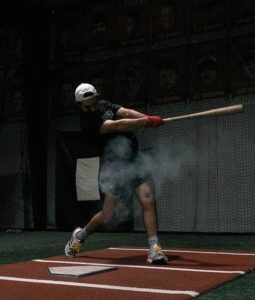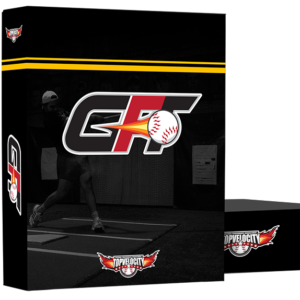We welcome you to our in-depth article on "Batting Exit Velo By Age," where we explore the concept of exit velocity and its importance in baseball. This metric is essential for assessing a player's success and potential because it provides information to both players and coaches. The relationship between bat speed and elite exit velocity, the proper ways to measure exit velocity, and the important variables to take into account for a precise evaluation are all covered in this article.
A good swing and a faster bat speed frequently produce a higher exit velocity and more ball travel. Bat speed and exit velocity are closely linked. Considerations for measuring exit velocity include the sort of ball, ball placement, and bat material. Players and coaches can pinpoint areas for development and create plans to maximize power output by looking at exit velocity along with other metrics like launch angle. Join us as we thoroughly examine batting exit velocity to give you the information and resources you need to comprehend and improve this crucial baseball metric.
Here are 6 key points summarizing this article on Exit Velo By Age:
- The significance of bat speed and exit velocity in maximizing hitting performance is discussed in the article, along with suggestions for development.
- Discussed are precise measurement methods and elements affecting exit velocity, such as ball type and location.
- Comparing the variations among aluminum, wooden, and composite bats and how they affect exit speeds.
- It is investigated how launch angle affects hitting results like line drives and home runs.
- Strength training, proper stroke mechanics, and bat selection are just a few methods for enhancing bat speed and exit velocity.
- A useful tool for players seeking to improve their performance is the GFT Hitting Program, a science-based training program created to increase hitting consistency and power.
Elite Level Exit Velo By Age Averages
| Player Age Range | Average Exit Velocity |
|---|---|
| Ages 8-10 | 56-65mph |
| Ages 11-13 | 66-75mph |
| Ages 14-15 | 76-80mph |
| Junior Varsity 15-16 | 80mph Aluminum / 75mph Wood |
| Varsity 15-18 | 90mph Aluminum / 85mph Wood |
| College Level | 95mph Aluminum / 90mph Wood |
| Professional Level | 100+mph Wood |
Exit Velo By Age Averages
| Player Name | Average Exit Velocity |
|---|---|
| Age 10 | 49-55mph |
| Age 11 | 49-55mph |
| Age 12 | 56-60mph |
| Age 13 | 61-65mph |
| Age 14 | 66-70mph |
| Age 15 | 71-75mph |
| Age 16 | 71-75mph |
| Age 17 | 76-80mph |
| Age 18 | 81-85mph |
| College | 86-90mph |
| Professional | 91-95mph |
Understanding the Relationship Between Bat Speed and Exit Velocity
 Bat speed and exit velocity are two crucial aspects to consider when assessing a baseball player's striking ability. Despite their similarities, it's important to recognize the differences between these two ideas and how they work together to affect a player's success at the plate.
Bat speed and exit velocity are two crucial aspects to consider when assessing a baseball player's striking ability. Despite their similarities, it's important to recognize the differences between these two ideas and how they work together to affect a player's success at the plate.
The pace at which the bat enters the hitting zone during a swing is referred to as bat speed. It serves as a gauge for the player's capacity for producing force as well as the possibility for energy transfer to the ball during contact. A greater exit velocity may result from more power being applied to the ball as a result of a faster bat speed. A player's capacity to produce bat speed is influenced by their strength, skill, and biomechanics.
The speed at which the ball exits the bat after being hit is known as exit velocity. This parameter, which is affected by both bat speed and contact quality, is a direct representation of the energy transfer from the bat to the ball during contact. The amount of distance a batted ball will move and whether it will be a hit or an out depends greatly on the exit velocity. Generally speaking, higher exit velocities are linked to improved hitting results, such as an increase in batting average and slugging percentage.
The connection between bat speed and exit velocity is not linear because the hitter's swing mechanics, point of impact, and bat angle during contact are all important considerations. Even if the bat speed is not materially faster than that of another player, an efficient swing that produces maximum bat speed and optimizes the point of impact can lead to a higher exit velocity. On the other hand, a player with a quick bat speed but poor stroke mechanics might not produce high exit velocities because of insufficient energy transfer.
In conclusion, it is essential to comprehend the connection between bat speed and exit velocity in order to assess and enhance a player's striking performance. Even though bat speed is crucial for producing high exit velocities, other factors, including swing effectiveness, mechanics, and contact quality, are also very important for optimizing the possible energy transfer to the ball.
Accurate Measurement Techniques for Exit Velo by Age
 Exit velo by age measurement accuracy is crucial for assessing a player's performance and potential as well as pinpointing areas that need development. To determine exit velocity, a variety of methods and instruments are available, each with benefits and drawbacks. The accuracy and relevance of the data gathered can be helped by comprehending these methods and selecting the one that best suits your requirements.
Exit velo by age measurement accuracy is crucial for assessing a player's performance and potential as well as pinpointing areas that need development. To determine exit velocity, a variety of methods and instruments are available, each with benefits and drawbacks. The accuracy and relevance of the data gathered can be helped by comprehending these methods and selecting the one that best suits your requirements.
Using a radar gun or other portable radar instrument is a common way to measure exit velocity. By sending out radio waves and timing how long it takes for the waves to bounce off the moving ball and return to the device, these devices can determine the speed of the ball as it departs the bat. Despite the fact that radar guns are frequently used in professional baseball and at scouting events, they can be costly and may not be the best choice for single players or small teams.
Using a bat tracker, such as Blast Motion or Diamond Kinetics SwingTracker, is an alternative and more practical choice. These tiny gadgets fit onto the knob of the bat and record information on swing metrics like bat speed, launch angle, and projected exit velocity using accelerometers, gyroscopes, and magnetometers. A player's swing mechanics can be better understood by using bat sensors, even though the exit velocity readings they provide may not be as precise as those from radar guns.
The Rapsodo or HitTrax devices are high-speed cameras that can be used to measure exit velocity. These devices monitor the ball's flight and provide information on exit velocity, launch angle, and other hitting metrics using high-speed video capture and sophisticated analytics. High-speed camera systems can be costly, but they offer a high degree of accuracy and give a thorough picture of a player's performance.
Regardless of the method selected, it is essential to keep constant conditions in order to measure exit velocity accurately and produce results that are comparable. Measurements of exit velocity can be impacted by elements like the style of ball, ball placement (off a tee or pitched), and bat material. Averaging the exit velocity from several readings can also be used to adjust for any irregularities or outliers in the data.
In order to assess and enhance a player's hitting ability, it is essential to precisely measure exit velocity. You can ensure the accuracy of the data gathered and make educated decisions about player development and strategy by being aware of the available methods and choosing the one that best suits your requirements.
Impact of Ball Type and Placement on Exit Velo by Age
 When measuring exit velo by age, the type of ball used and where it was placed can have a big effect on the outcomes, so it's important to take these things into account. The ability to compare and evaluate a player's potential and development more effectively depends on being aware of how ball type and location affect exit velocity measurements.
When measuring exit velo by age, the type of ball used and where it was placed can have a big effect on the outcomes, so it's important to take these things into account. The ability to compare and evaluate a player's potential and development more effectively depends on being aware of how ball type and location affect exit velocity measurements.
Due to variations in design, composition, and general quality, different baseballs can impact exit velocity differently. For instance, compared to a fresh, game-ready ball, a well-used practice ball may generate lower exit velocities. It is essential to use a game-ready ball that closely matches the kind of baseball used in competitive play in order to get precise and reliable exit velocity measurements. Additionally, any discrepancies brought on by variations in ball construction and quality can be eliminated by using the same variety of ball for all measurements.
Measurements of departure velocity can also be influenced by where the ball is placed, whether off a tee or from a pitched ball. The ball's position, height, and angle can be more precisely controlled when using a tee, creating a more reliable and steady environment for monitoring exit velocity. Tee work is typically used in combines and scouting events to measure exit velo by age because it allows more precise comparisons between players. Exit velocity may also be useful to measure during live batting practice or game scenarios because hitting a pitched ball requires different timing and swing mechanics than hitting off a tee.
It's crucial to check that the ball is positioned optimally in relation to the hitter's stance and swing when gauging exit velocity off a tee. The hitter will be able to make solid impact and produce the highest exit velocity with this placement. On the other hand, an incorrectly positioned ball may cause poor contact and slower exit velocities, distorting the measurement findings.
In conclusion, the kind of ball used and where it is positioned during exit velocity measurements can have a big influence on the precision and consistency of the outcomes. You can get more accurate exit velocity measurements by using a game-ready ball and making sure the ball is placed correctly, which enables more useful assessments and comparisons of a player's success and potential.
Comparing Exit Velocities with Aluminum, Wooden, and Composite Bats
 The type of bat used to measure exit velocity can have a big effect on the outcomes because different bat materials have different properties that affect how much energy is transferred when a ball makes contact with them. Knowing the differences between aluminum, wooden, and composite bats can help coaches and players make educated choices when choosing the best bat for their needs by illuminating the effects of bat material on exit velocity.
The type of bat used to measure exit velocity can have a big effect on the outcomes because different bat materials have different properties that affect how much energy is transferred when a ball makes contact with them. Knowing the differences between aluminum, wooden, and composite bats can help coaches and players make educated choices when choosing the best bat for their needs by illuminating the effects of bat material on exit velocity.
Aluminum bats, also referred to as metal or alloy bats, are distinguished from their wooden counterparts by having bigger sweet spots and lighter swing weights. These characteristics cause a trampoline effect upon impact, which can result in higher exit velocities and increased bat speed. But it's important to remember that while professional baseball players are obliged to use wooden bats, youth and amateur teams typically use aluminum bats.
Using wooden bats, which are frequently made of maple, ash, or birch, has a more traditional feel, but it also requires more ability to get the best contact and exit velocities. Wooden bats typically have smaller sweet spots and are less forgiving than aluminum or composite bats, which results in lower exit speeds. Coaches and scouts frequently prefer to measure players' exit velocities using wooden bats, however, as professional leagues require them, in order to get a more accurate picture of their success and promise at higher levels of play.
Comparable to aluminum and wooden bats, composite bats have a bigger sweet spot and less vibration thanks to a combination of carbon fibers, graphite, and other materials. These characteristics may help to improve exit speeds and the player's hitting experience. However, due to their potential performance benefits, composite bats are frequently more costly and might not be permitted in some leagues.
As a result, the type of bat used can have a big impact on exit velocities. Aluminum and composite bats typically have greater exit velocities than wooden bats. However, it is crucial to take into account the context and requirements of the league a player is competing in or striving for when assessing their performance and potential. In order to predict a player's bat speed and potential at higher levels of play, coaches, scouts, and players should give priority to measuring exit velocities with wooden bats.
The Role of Launch Angle in Optimizing Hitting Performance
 In addition to departure velocity, the launch angle - the vertical angle at which the ball exits the bat after contact - is another crucial element in maximizing hitting performance. Players can improve their odds of having successful hitting outcomes by modifying their swing mechanics and approach at the plate by understanding the connection between exit velocity and launch angle.
In addition to departure velocity, the launch angle - the vertical angle at which the ball exits the bat after contact - is another crucial element in maximizing hitting performance. Players can improve their odds of having successful hitting outcomes by modifying their swing mechanics and approach at the plate by understanding the connection between exit velocity and launch angle.
An batted ball's flight and final result are greatly influenced by the launch angle. Ground balls can result from low launch angles, typically under 10 degrees, while fly balls or pop-ups are frequently produced by high launch angles, typically above 25 degrees. Line drives are more likely to be hit with an optimum launch angle, which is typically thought to be between 10 and 25 degrees. Line drives are more likely to result in base hits and extra-base hits.
Players should work to achieve a combination of high exit velocity and ideal launch angle to optimize hitting performance. Hard-hit line drives are more difficult for the defense to field and are more likely to result in hits when a high exit velocity and an optimal launch angle are combined. Additionally, home runs can result from higher exit velocities and higher launch angles, having a significant offensive effect.
The statistics on a player's launch angle can be analyzed and understood to help pinpoint areas where their approach and swing mechanics need work. To produce more line drives and fly balls, for example, a player who regularly generates high exit velocities but has a low launch angle may need to change their swing plane. In contrast, to improve their hitting results, a player with a typically high launch angle but comparatively low exit velocities may need to work on increasing their bat speed and contact quality.
In conclusion, it is important to recognize the importance of launch angle in maximizing hitting effectiveness. Players can improve their overall offensive effect by modifying their swing mechanics and approach with knowledge of the connection between exit velocity and launch angle. High exit velocity in conjunction with an ideal launch angle can increase the likelihood of hitting effective outcomes like line drives, extra-base hits, and home runs.
Strategies for Improving Bat Speed and Exit Velo by Age
 Enhancing a player's hitting ability and offensive effect on the game requires improving bat speed and exit velo by age. Players can develop the necessary strength, mechanics, and approach to consistently produce higher bat speeds and exit velocities by putting specific strategies and focused training methods into practice.
Enhancing a player's hitting ability and offensive effect on the game requires improving bat speed and exit velo by age. Players can develop the necessary strength, mechanics, and approach to consistently produce higher bat speeds and exit velocities by putting specific strategies and focused training methods into practice.
Strength and conditioning: Increasing overall strength is crucial for boosting bat speed, especially in the midsection, legs, and upper body. A swing's power-generating muscles can be developed by including strength training routines like squats, deadlifts, lunges, and rotational movements in your routine. Additionally, plyometric workouts can help increase power output and bat speed, such as medicine ball throws and explosive push-ups.
Swing technique: For maximizing bat speed and departure velocity, a good swing technique is essential. Players can improve their swing mechanics by working with an experienced coach to evaluate and fine-tune them. This will help them make the required changes for a more powerful and effective swing. Proper weight transfer, hip rotation, hand placement, and keeping a balanced and fluid swing are important factors to pay attention to.
Exit velocity can be increased by being aware of how to control the bat during an at-bat and make necessary changes. Players can improve their ability to adjust and maintain consistency at the plate by working on driving the ball to all fields while practicing different pitch locations and types. To increase exit velocities, hitting drills that emphasize bat control, like soft-toss and tee work, can also be used.
Selecting the correct bat is crucial for maximizing exit velocity and bat speed. Players should choose a bat that is suitable for their degree of skill and physical capabilities in terms of length, weight, and material. Reduced exit velocities can result from a player's inability to produce maximum bat speed with a bat that is too heavy or long.
Repetition and practice: As with any ability, increasing bat speed and exit velocity requires regular practice. Players can gradually advance and eventually improve their performance at the plate by devoting time to focused hitting drills, strength and conditioning, and swing analysis.
In summation, a player's bat speed and exit velocity can be greatly improved by using focused strategies and training techniques. Players can improve their hitting performance and make a greater contribution to their team's offensive success by concentrating on strength and fitness, fine-tuning swing mechanics, enhancing bat control and approach, choosing the right bat, and committing to consistent practice.
Discover the Power of the GFT Hitting Program and Elevate Your Bat Velocity Today!
 Do you wish to improve your swing speed and reach your full offensive potential? Look no further than the GFT Hitting Program, a state-of-the-art training program based on countless case studies from baseball players all over the globe and over 15 years of scientific research. You can regularly make optimal contact and hit for power with the aid of this program, two skills that are necessary for rising through the ranks of the game.
Do you wish to improve your swing speed and reach your full offensive potential? Look no further than the GFT Hitting Program, a state-of-the-art training program based on countless case studies from baseball players all over the globe and over 15 years of scientific research. You can regularly make optimal contact and hit for power with the aid of this program, two skills that are necessary for rising through the ranks of the game.
The GFT Hitting Program utilizes the combined knowledge of countless case studies and biometric data from high school to professional baseball players to concentrate on the fundamentals of hitting, pitching, and throwing. The program's signature technique, Ground Force Torque, is founded on the scientific theory that better hitters can successfully use ground force and can manage their hips and torso to transfer energy efficiently.
The GFT Hitting Program, created by a former professional two-way player (pitcher and outfielder), emphasizes the value of learning the science of hitting for your growth. By following the program's instructions and combining the Fusion System with the 2X Velocity Program, you'll gain access to a strategy based on the most recent study and designed to make you a better athlete and hitter.
Don't let a lack of information or stale training techniques prevent you from realizing your full potential. Invest in the GFT Hitting Program right away to see the impact science-based training can have on your at-the-plate success. Let's continue to advance the science of hitting and improve baseball together by sharing our insights and findings with other players and our team.
Join the GFT Hitting Program today to access the power of science-based hitting instruction. Make the first move toward improving your hitting efficiency, strength, and success. To buy the program and start your transformation right away, click the link.





Trackbacks/Pingbacks